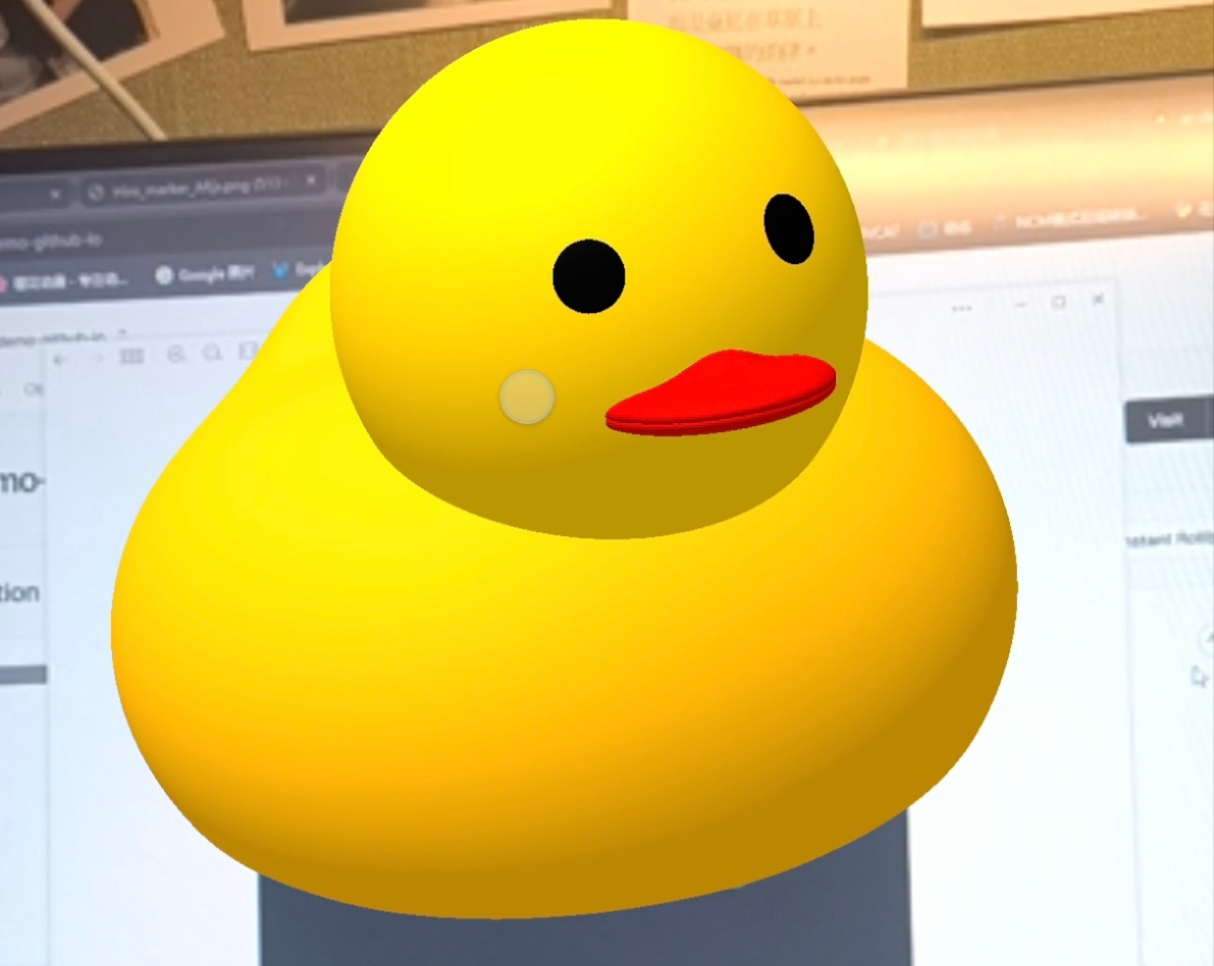AR技术真的来势汹汹,我们也要跟进时代;平常我们给企业展示模型都是直接在大屏上展示,用ThreeJS写逻辑。这样固然很好,但是是不是还能做的更好呢?
“我要在手机上也能看我的模型!”
一句简单需求让我这一天抓耳挠腮的;通过查阅资料,我发现目前已经有个相对成熟的方案,可以通过AR.js和Aframe框架来使模型在手机上展示

接下来我们将载入Aframe和AR.js的资源库
<script src="https://aframe.io/releases/1.2.0/aframe.min.js"></script>
<script src="https://raw.githack.com/AR-js-org/AR.js/master/aframe/build/aframe-ar.js"></script>创建场景:
<a-scene
arjs
embedded
renderer="logarithmicDepthBuffer: true;"
vr-mode-ui="enabled: false"
gesture-detector
id="scene"
>
<a-entity camera></a-entity>
</a-scene><a-scene>是Aframe的最主要的控件,用于创建一个场景,<a-entity camera>是相机组件,同时我们需要通过添加额外属性使其正确展示
属性解释
arjs
引入Aframe组件,加载3D资源
embedded
场景用嵌入式模式运行,不用全屏
renderer="logarithmicDepthBuffer: true;"
定义渲染器,启用对数深度缓冲区提高精度优化性能
vr-mode-ui="enabled: false
禁用VR(开个坑,等我什么时候买VR再写hiahiahia)
gesture-detector
启用拖动组件,这是我们待会要讲到的妙妙工具!
id="scene"
定义id
现在,我们要在场景内添加实体模型:<a-marker>、<a-entity>
<!-- Marker A - 显示黄色小鸭 -->
<a-marker
type="pattern"
url="assets/pattern-markerA.patt"
raycaster="objects: .clickable"
emitevents="true"
cursor="fuse: false; rayOrigin: mouse;"
id="markerA"
>
<a-entity
gltf-model="#model1"
position="0 0 0"
scale="0.5 0.5 0.5"
class="clickable"
gesture-handler
>
</a-entity>
</a-marker>
<!-- Marker B - 显示 iPhone -->
<a-marker
type="pattern"
url="assets/pattern-markerB.patt"
raycaster="objects: .clickable"
emitevents="true"
cursor="fuse: false; rayOrigin: mouse;"
id="markerB"
>
<a-entity
gltf-model="#model2"
position="0 0 0"
scale="0.5 0.5 0.5"
class="clickable"
gesture-handler
>
</a-entity>
</a-marker>
<a-marker>是模型标识符,即你扫描的hiro图片,AR.js提供了三种供扫描的形式:
- Hiro (标识符)
- Barcode (条码)
- Pattern (图案)
<a-entity>是模型实体,定义了路径和点击事件等
你可以通过默认的Hiro图片来扫描

也可以在AR.js Marker Training 中上传自定义图片来扫描:

(如果使用自己的图片需要使用pattern属性,并添加url路径定义到你的patt图片)
对与模型交互事件,我编写了个手势交互的组件,实现模型单指旋转、拖拽,双指放大,只需再script处导入即可
AFRAME.registerComponent("gesture-handler", {
schema: {
enabled: { default: true },
rotationFactor: { default: 5 },
minScale: { default: 0.3 },
maxScale: { default: 8 },
},
init: function () {
this.handleScale = this.handleScale.bind(this);
this.handleRotation = this.handleRotation.bind(this);
this.isVisible = false;
this.initialScale = this.el.object3D.scale.clone();
this.scaleFactor = 1;
this.el.sceneEl.addEventListener("markerFound", (e) => {
this.isVisible = true;
});
this.el.sceneEl.addEventListener("markerLost", (e) => {
this.isVisible = false;
});
},
update: function () {
if (this.data.enabled) {
this.el.sceneEl.addEventListener("onefingermove", this.handleRotation);
this.el.sceneEl.addEventListener("twofingermove", this.handleScale);
} else {
this.el.sceneEl.removeEventListener("onefingermove", this.handleRotation);
this.el.sceneEl.removeEventListener("twofingermove", this.handleScale);
}
},
remove: function () {
this.el.sceneEl.removeEventListener("onefingermove", this.handleRotation);
this.el.sceneEl.removeEventListener("twofingermove", this.handleScale);
},
handleRotation: function (event) {
if (this.isVisible) {
this.el.object3D.rotation.y +=
event.detail.positionChange.x * this.data.rotationFactor;
this.el.object3D.rotation.x +=
event.detail.positionChange.y * this.data.rotationFactor;
}
},
handleScale: function (event) {
if (this.isVisible) {
this.scaleFactor *=
1 + event.detail.spreadChange / event.detail.startSpread;
this.scaleFactor = Math.min(
Math.max(this.scaleFactor, this.data.minScale),
this.data.maxScale
);
this.el.object3D.scale.x = this.scaleFactor * this.initialScale.x;
this.el.object3D.scale.y = this.scaleFactor * this.initialScale.y;
this.el.object3D.scale.z = this.scaleFactor * this.initialScale.z;
}
},
});
AFRAME.registerComponent("gesture-detector", {
schema: {
element: { default: "" }
},
init: function() {
this.targetElement =
this.data.element && document.querySelector(this.data.element);
if (!this.targetElement) {
this.targetElement = this.el;
}
this.internalState = {
previousState: null
};
this.emitGestureEvent = this.emitGestureEvent.bind(this);
this.targetElement.addEventListener("touchstart", this.emitGestureEvent);
this.targetElement.addEventListener("touchend", this.emitGestureEvent);
this.targetElement.addEventListener("touchmove", this.emitGestureEvent);
},
remove: function() {
this.targetElement.removeEventListener("touchstart", this.emitGestureEvent);
this.targetElement.removeEventListener("touchend", this.emitGestureEvent);
this.targetElement.removeEventListener("touchmove", this.emitGestureEvent);
},
emitGestureEvent(event) {
const currentState = this.getTouchState(event);
const previousState = this.internalState.previousState;
const gestureContinues =
previousState &&
currentState &&
currentState.touchCount == previousState.touchCount;
const gestureEnded = previousState && !gestureContinues;
const gestureStarted = currentState && !gestureContinues;
if (gestureEnded) {
const eventName =
this.getEventPrefix(previousState.touchCount) + "fingerend";
this.el.emit(eventName, previousState);
this.internalState.previousState = null;
}
if (gestureStarted) {
currentState.startTime = performance.now();
currentState.startPosition = currentState.position;
currentState.startSpread = currentState.spread;
const eventName =
this.getEventPrefix(currentState.touchCount) + "fingerstart";
this.el.emit(eventName, currentState);
this.internalState.previousState = currentState;
}
if (gestureContinues) {
const eventDetail = {
positionChange: {
x: currentState.position.x - previousState.position.x,
y: currentState.position.y - previousState.position.y
}
};
if (currentState.spread) {
eventDetail.spreadChange = currentState.spread - previousState.spread;
}
Object.assign(previousState, currentState);
Object.assign(eventDetail, previousState);
const eventName =
this.getEventPrefix(currentState.touchCount) + "fingermove";
this.el.emit(eventName, eventDetail);
}
},
getTouchState: function(event) {
if (event.touches.length === 0) {
return null;
}
const touchList = [];
for (let i = 0; i < event.touches.length; i++) {
touchList.push(event.touches[i]);
}
const touchState = {
touchCount: touchList.length
};
const centerPositionRawX =
touchList.reduce((sum, touch) => sum + touch.clientX, 0) /
touchList.length;
const centerPositionRawY =
touchList.reduce((sum, touch) => sum + touch.clientY, 0) /
touchList.length;
touchState.positionRaw = { x: centerPositionRawX, y: centerPositionRawY };
const screenScale = 2 / (window.innerWidth + window.innerHeight);
touchState.position = {
x: centerPositionRawX * screenScale,
y: centerPositionRawY * screenScale
};
if (touchList.length >= 2) {
const spread =
touchList.reduce((sum, touch) => {
return (
sum +
Math.sqrt(
Math.pow(centerPositionRawX - touch.clientX, 2) +
Math.pow(centerPositionRawY - touch.clientY, 2)
)
);
}, 0) / touchList.length;
touchState.spread = spread * screenScale;
}
return touchState;
},
getEventPrefix(touchCount) {
const numberNames = ["one", "two", "three", "many"];
return numberNames[Math.min(touchCount, 4) - 1];
}
});
导入组件后,添加标签属性就可以实现功能啦!
但是对于企业或者多维度需求,只扫hiro标识局限性太大,所以我们需要用到第三种:“扫描图片后展示图形”友情链接:NFT-Creator-Web,你可以在这转换为NFT图形
在这里我直接贴出HTML代码,方便学习:
<!DOCTYPE html>
<html>
<head>
<title>Gesture Interactions - A-Frame & AR.js</title>
<meta charset="utf-8" />
<meta http-equiv="X-UA-Compatible" content="IE=edge" />
<link rel="stylesheet" href="styles.css" />
<script src="https://aframe.io/releases/1.2.0/aframe.min.js"></script>
<script src="https://raw.githack.com/AR-js-org/AR.js/master/aframe/build/aframe-ar-nft.js"></script>
<script src="./gestures.js"></script>
</head>
<body>
<a-scene
arjs="trackingMethod: best; sourceType: webcam; debugUIEnabled: false;"
embedded
renderer="logarithmicDepthBuffer: true;"
vr-mode-ui="enabled: false"
gesture-detector
id="scene"
>
<a-nft
type="nft"
url="./assets/earth"
smooth="true"
smoothCount="10"
smoothTolerance=".01"
smoothThreshold="5"
raycaster="objects: .clickable"
emitevents="true"
cursor="fuse: false; rayOrigin: mouse;"
>
<a-entity
gltf-model="./assets/earth.glb"
scale="5 5 5"
position="0 0 0"
class="clickable"
gesture-handler
>
</a-entity>
</a-nft>
<a-nft
type="nft"
url="./assets/pinball"
smooth="true"
smoothCount="10"
smoothTolerance=".01"
smoothThreshold="5"
raycaster="objects: .clickable"
emitevents="true"
cursor="fuse: false; rayOrigin: mouse;"
>
<a-sphere
radius="5"
color="blue"
position="50 0 0"
scale="20 20 20"
class="clickable"
gesture-handler
>
</a-sphere>
</a-nft>
<a-entity camera></a-entity>
</a-scene>
</body>
</html>
只需要改变一个实例:<a-marker> => <a-nft>,其余逻辑一致
注:转换为NFT后会出现3个文件:“.fset”、“.fset3”、“.iset”,只需把它全部放入assets文件夹汇中,导入时保证名字一致,直接引用文件名,不需要加文件后缀
type="nft"
url="./assets/pinball"
快来下载我的资源包试试看吧!

























 被折叠的 条评论
为什么被折叠?
被折叠的 条评论
为什么被折叠?








